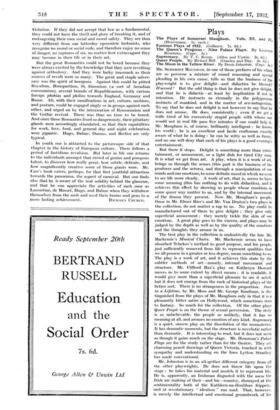Boulevards and Barricades
Ma. CARR is an incorrigible lover of France and the French, and those readers who know his book about French domestic life and the special civilization which it symbolizes, will expect his new book to be rich in "chatty," picturesque detail produced from an enormous store of incidental knowledge. They will not be disappointed ; for these chapters, together with their sixty illustrations—portraits, scenes, cartoons, &c.—arc almost as enlivening as a visit to Paris. One meets crowds of brilliant men and women in the salons, along the boulevards, and at the barricades of 1830 and 1848. In those crowds, and directing them, move the giants of the Romantic Move- ment, masquerading, loving, eating and working, their lives
given with immense gusto to a superb exhibitionism.
For, as Mr. Car; points out in one of the many moments when he pauses to make a comment while the reader takes breath and rests his cars and eyes,
' the Romantics gloried in the conflicts and the tires and the passion for their own sake, and, in so doing, they ignored both the laws of nature and the laws which man has made for the stability of society—and he has always regarded society as more important than the individual. Love is not a god, but a demon, not a rule of life, but one of the forces of life, and therefore to be feared, not to ho enjoyed, but to be endured."
Mr. Carr shows, by his myriad-snapshot method, that the Romantics offered no philosophy to contradict this classical rule. They supported it, indeed, by a negative process of
'violation. If they did not accept that law as a fundamental, they could not have the thrill and glory of breaking it, and of endangering their own social and moral safety. They are thus 'Very different from our latterday egocentric hedonists, who recognize no moral or social code, and therefore enjoy no sense of danger, no raptures of sin, no matter how extravagant they may become in their life or in their art.
But the great Romantics could not be bored because they were always excited by the knowledge that they were revolting against orthodoxy. And they were lucky inasmuch as their sources of revolt were so many. The great and staple adver- sary was the spirit of bourgeois. Against this could be pitted Royalism, Bonopartism, St. Simonism ( a sort of Arcadian communism), several brands of Republicanism, with various foreign phobias and philias towards England, Germany and Rome. All, with their ramifications in art, culture, snobism, and posture, could be engaged singly or in groups against each other, and urged on by the intoxication of Rousseauism and the Gothic revival. There was thus no time to be bored. 'And since those Romantics lived so dangerously, their pituitary glands were accordingly stimulated, so that their capabilities for work, love, food, and general day and night celebration were gigantic. Hugo, Balzac, Dumas, and Berlioz are only typical.
In youth one is attracted to the picturesque side of that chapter in the history of European culture. There follows a period of fastidious revulsion. But later in life one returns to the individuals amongst that crowd of genius and pompous talent, to discover how really great, how subtle, delicate, and how magnificently creative some of those giants were. Mr. Carr's book caters, perhaps, for that first youthful attraction towards the panorama, the aspect of carnival. But one finds also that he is aware of the real solidity behind the glamour, and that he can appreciate the activities of such men as Lamartine, de Musset, Hugo, and Balzac when they withdrew themselves from the mob and used their brains and pens to a































 Previous page
Previous page